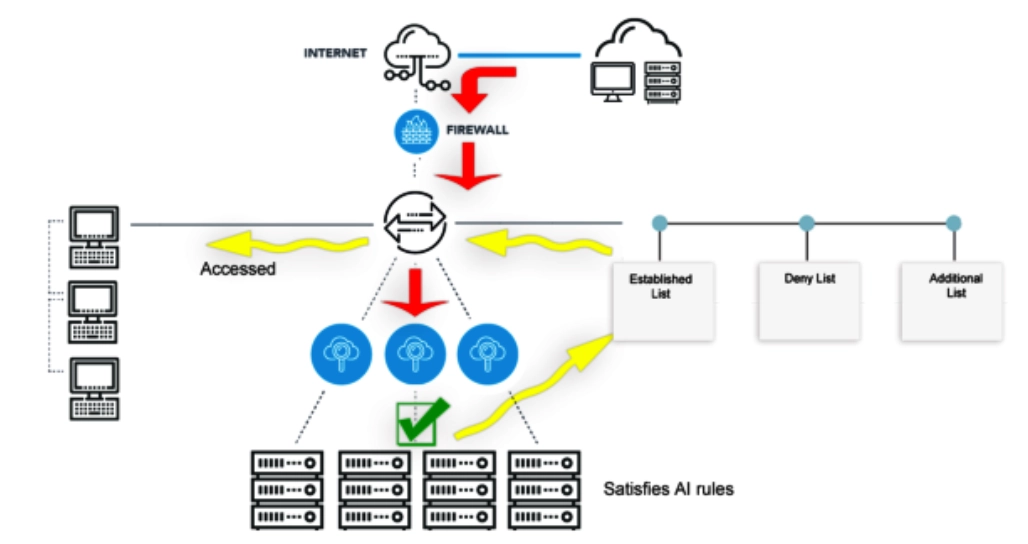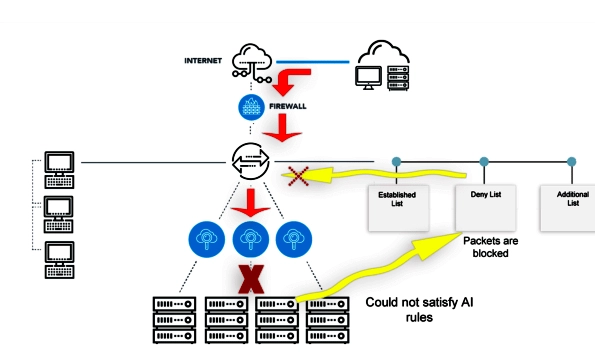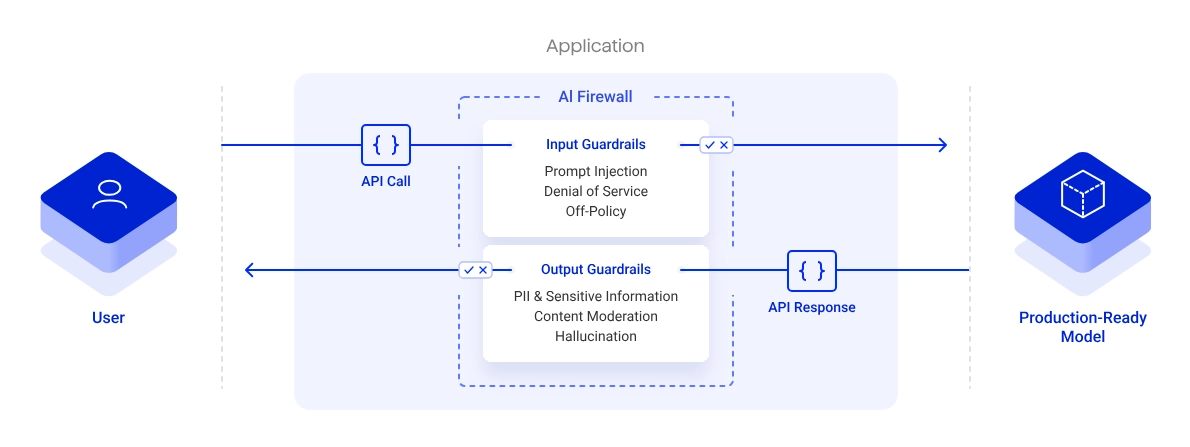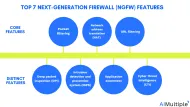A threat hunt is estimated to take 194 days to identify an advanced threat, according to cyber security stats.1 To improve the threat detection and prevention process, businesses are increasingly relying on artificial intelligence-based security solutions, leading to the AI in the cybersecurity market being projected to reach approximately $45 billion by 2027.2
See features and top vendors of both AI-powered firewalls and firewalls for AI applications:
Top 3 AI Firewalls
| Tool Name | User Rating* | Number of Employees** |
|---|---|---|
| FortiGate NGFW | 4.6 out of 238 reviews | |
| Check Point Quantum Force | 4.5 out of 369 reviews | 7,852 |
| Huawei AI Firewall | 4.7 out of 15 reviews | 159,537 |
* Based on data from B2B review platforms
** Based on data from LinkedIn
1. FortiGate NGFW
FortiGate Next-Generation Firewall provides AI/ML-powered threat protection and supports the integration of networking and security. FortiGate NGFW operates on a unified FortiOS platform, which Fortigate claims to ensure consistent functionality across various environments, including appliances, virtual setups, and secure access service edge (SASE) solutions.
2. Check Point Quantum Force
Quantum Next Generation Firewalls provide comprehensive network security, including remote access VPN, SASE, SD-WAN, and protection against IoT, DDoS, and zero day attacks. They claim to deliver threat prevention, flexible scalability, and system resilience, supporting enterprise environments across core, perimeter, and branch networks.
3. Huawei AI Firewall
Huawei AI Firewalls offer terabit-level threat mitigation at the network edge, ideal for cloud data centers, large enterprises, and campus networks. Their hardware design includes energy conservation tech and features like dual MPU backup and software integrity checks, providing comprehensive security for heavy-bandwidth traffic and diverse service threats.
A hardware-based integrity check stops unauthorized software from running, thereby establishing a secure foundation for the network.
Figure 1. Features of Huawei AI Firewall

What is an AI Firewall?
An artificial intelligence (AI) firewall, an evolution of next-generation firewalls (NGFW), employs intelligent detection technologies to enhance the detection of advanced and unknown threats.
Unlike traditional NGFWs, an important tool in network security, that rely on a static rule database, AI firewalls utilize an intelligent detection engine that enables firewalls to deal with variant threats. This engine threat detection models using vast amounts of sample data, optimizes these models based on real-time traffic, and significantly improves threat detection capabilities.
AI firewalls vs next-generation firewalls (NGFW)
The main capabilities of next-generation firewalls (NGFWs) include application identification and integrated intrusion prevention systems (IPS) for in-depth traffic detection.
AI firewalls, compared to NGFWs, leverage intelligence by using a vast amount of samples and algorithms to train threat detection models, enabling them to detect advanced and unknown threats. This advanced functionality requires dedicated computing hardware to enhance threat detection performance.
While NGFWs focus on inspecting and filtering network traffic based on predefined rules, applications, and signatures, AI firewalls use advanced algorithms to detect and respond to complex threats, including those targeting AI systems themselves. The distinction lies in the level of intelligence and adaptability they bring to network security.
Figure 2. Process of AI-based firewalls if the packet satisfies AI rules

Source: Building New Generation Firewall Including Artificial Intelligence3
Figure 3. Process of AI-based firewalls if the packet does not satisfy AI rules

Source: Building New Generation Firewall Including Artificial Intelligence4
As summarized in the figures above, packets that the training rule set of AI firewalls are listed as trusted, and the connection can be made with the end user devices.
Characteristics of AI Firewalls
AI firewalls incorporate several advanced features that significantly enhance their capabilities beyond traditional firewall systems:
- Automatic load balancing: AI firewalls ensure that input prompts are evenly distributed across multiple servers, preventing any single server from becoming a bottleneck. This is crucial for maintaining performance and preventing distributed denial of service (DDoS) attacks, which can overwhelm traditional apps and AI systems alike.
- Proactive threat hunting: These firewalls continuously monitor for potential threats by analyzing input prompts and AI model responses. This helps identify and mitigate risks before they can exploit vulnerabilities, ensuring that confidential information remains secure and customers receive reliable responses.
- Adaptive learning: AI firewalls utilize adaptive learning to improve their defenses over time. By analyzing patterns and behaviors in input prompts and responses, they can adjust their rules and algorithms to better protect against emerging threats, enhancing the security of AI gateways and LLMs.
- Rate limiting: To protect against volumetric attacks, AI firewalls can implement rate limiting policies. This controls the rate of requests from individual sessions, helping to prevent distributed denial-of-service attacks that could overwhelm AI models and degrade performance.
- Sensitive data detection (SDD): By identifying and managing confidential information within input prompts and responses, AI firewalls prevent accidental exposure of sensitive data. This feature is particularly useful in ensuring that large language models do not inadvertently disclose private or proprietary information.
Top 3 Firewalls for AI
| Tool | User Rating* | Number of Employees** |
|---|---|---|
| Nightfall AI | 4.7 out of 83 review | 110 |
| Cloudflare Firewall for AI | 4.6 out of 778 review | 4,773 |
| Robust Intelligence AI Firewall | 4.5 out of 2 review | 72 |
1. Nightfall AI
Nightfall AI Firewall uses AI-powered detection to identify sensitive data and ensure compliance with standards like GDPR, CCPA, and HIPAA. It claims to provide a flexible platform for protecting interactions with GenAI APIs and filtering sensitive data before it is shared or stored.
2. Cloudflare Firewall for AI
Cloudflare’s Firewall for AI operates akin to a traditional web application firewall, analyzing every request to identify attack signatures, preventing volumetric attacks, and employing sensitive data detection to safeguard against information disclosure.
Additionally, it addresses model abuses like prompt injections and provides prompt and response validation to ensure responses align with defined boundaries, enhancing overall model security and reliability.
3. Robust Intelligence AI Firewall
Figure 4. AI protection diagram

Source: Robust Intelligence5
The Robust Intelligence AI Firewall provides real-time protection for AI applications, automatically configured to address specific model vulnerabilities. Using proprietary techniques like algorithmic red teaming and threat intelligence research, it updates to mitigate emerging threats, including prompt injections and adversarial techniques.
What is a firewall for AI?
A firewall for AI is a security solution designed to protect AI models, particularly large language models (LLMs), by monitoring and filtering their inputs and outputs. A firewall for AI, distinct from traditional firewall, protects AI models and provides LLM security by monitoring and managing input prompts and outputs.
It detects and mitigates threats like prompt injection, sensitive data exposure, and data poisoning using machine learning and natural language processing. Unlike a traditional web application firewall focused on network traffic, an AI firewall ensures the security of generative AI-powered applications by blocking problematic language and unintended responses, providing robust protection for AI systems and end users.
Features of firewalls for AI applications
Features of firewalls for AI collectively contribute to the benefits, such as preventing volumetric attacks, sensitive data leaks, model abuses, and ensuring seamless scalability and confidentiality of data in AI systems.6
- Rate limiting policies: This feature controls the rate of requests from individual sessions, preventing volumetric attacks by limiting the context window and reducing the impact of resource-intensive requests.
- Sensitive data detection (SDD): SDD feature identifies and blocks sensitive information leaks, including personally identifiable information (PII) and proprietary data leaving the model. It integrates with AI gateways and allows for custom rule creation for detecting specific types of sensitive data.
- Prompt and response validation: AI firewalls run detections to identify prompt injection attempts and other abuses, ensuring that the AI application generates reliable and non-toxic responses. It provides a scoring mechanism to assess the likelihood of prompt injections and enables the creation of rules based on these scores.7
- Continuous improvement: The firewall needs to continuously update threat detection techniques to stay ahead of emerging cybersecurity challenges.
FAQs
How do LLMs differ from traditional applications?
LLMs are non-deterministic by design, making it harder to identify problematic requests. LLMs, as internet connected applications, interact with users through natural language, which makes identifying attacks more challenging. LLMs are different in that the training data becomes part of the model itself, making it difficult to control how that data is shared.
Traditional firewalls operate on the data plane, while LLMs require a different approach to security, as the risks go beyond just the traffic itself. The data plane and control plane are more tightly integrated in LLMs.
What are the technologies used in AI firewalls?
AI-powered firewalls use a plethora of technologies that address the limitations of traditional firewalls and next-generation firewalls (NGFWs), ensuring robust network security and protection of confidential data. Here are some key technologies of AI firewalls8 :
1. Machine learning approaches
1.1. Supervised learning
AI firewalls use supervised learning models, which are trained on labeled datasets, to identify known threats. These models excel in recognizing patterns and features indicative of malicious activities, enabling security teams to detect and block attacks effectively. By continuously learning from vast amounts of training data, these models can adapt to the latest threats, providing robust protection against advanced threats.
1.2. Unsupervised learning
Unsupervised learning methods are adept at detecting anomalies in network traffic without the need for predefined labels. This capability is crucial for identifying novel and emerging threats that traditional web application firewalls might miss. By analyzing live network data, unsupervised learning models can identify deviations from normal behavior, helping to prevent sensitive data exposure and other security breaches.
2. Deep learning architectures
2.1. Convolutional neural networks (CNNs)
CNNs are highly effective in extracting intricate features from network data, making them ideal for malware detection. By analyzing the spatial hierarchies within the data, CNNs can identify subtle patterns associated with malicious activities, enhancing the firewall’s ability to protect against sophisticated attacks.
2.2. Recurrent neural networks (RNNs)
RNNs are well-suited for sequential learning and dynamic threat analysis. These networks can identify evolving threats that manifest over time, providing a robust defense against persistent threats. By leveraging the depth and complexity of RNNs, AI firewalls can continuously adapt to new attack vectors, ensuring comprehensive network security.
3. Behavioral analysis
Behavioral analysis involves the continuous monitoring and learning of normal network behavior to proactively identify and mitigate potential threats. Reinforcement learning, in particular, allows AI firewalls to adapt and learn from changing network dynamics over time. This approach enhances the accuracy of threat detection and facilitates a more adaptive and responsive defense mechanism.
4. Real-time threat intelligence
4.1. Dynamic analysis and response
Real-time threat intelligence enables AI firewalls to dynamically analyze and respond to emerging threats. By incorporating artificial intelligence into the threat intelligence framework, these firewalls can minimize response times and fortify defenses against sophisticated attacks.
4.2. Continuous updates
AI firewalls can continuously update their threat detection models based on the latest intelligence, ensuring that they remain adaptive and resilient in the face of rapidly evolving cyber threats. This continuous improvement process helps protect sensitive information and prevent reputational damage.
5. Adversarial attacks and defenses
5.1. Robust defense mechanisms
AI firewalls are equipped with robust defenses against adversarial attacks, which involve manipulating input data to deceive AI models. Techniques such as adversarial training, input diversification, and anomaly detection mechanisms help fortify these firewalls against such manipulative tactics.
5.2. Adaptive security measures
The continuous innovation in AI-based firewalls ensures that they can identify and thwart adversarial attacks, maintaining the integrity of network security. This adaptability is essential for keeping pace with the evolving tactics of cyber adversaries.
Further Reading
- Analysis of Top 4 Open Source NGFW Based on Features
- AI Network Automation by 7+ Use Cases & Case Studies
- Open Source Firewall Options
External Links
- 1. What Is Threat Hunting? | IBM.
- 2. U.S. Legal Cannabis Market Sales To Soar To $45 Billion In 2027.
- 3. Chakraborty, P., Rahman, M. Z., & Rahman, S. (2019). Building new generation firewall including artificial intelligence. International Journal of Computer Applications, 975, 8887. Accessed: 30/May/2024.
- 4. Chakraborty, P., Rahman, M. Z., & Rahman, S. (2019). Building new generation firewall including artificial intelligence. International Journal of Computer Applications, 975, 8887. Accessed: 30/May/2024.
- 5. Protect your AI applications in real time — Robust Intelligence.
- 6. Cloudflare announces Firewall for AI.
- 7. 5 things you need to know to build a firewall for AI | Nightfall AI.
- 8. Ahmadi, S. (2023). Next Generation AI-Based Firewalls: A Comparative Study. International Journal of Computer (IJC), 49(1), 245-262. Accessed: 29/May/2024.



Comments
Your email address will not be published. All fields are required.